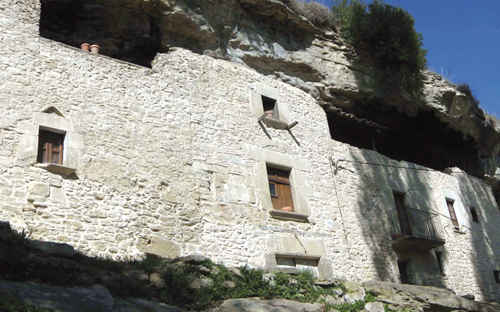Places to visit with in the Ecomuseum

In order to arrange visits:
turisme@consorcidelmoianes.cat
Telephone: 93 830 14 18
*Prices: more than 18 years: 3€ / from 8 to 17 years: 1€/ until 7 years: free
The five Ecomuseum branches or centres project that can be visited are:

LIME KILN
An element made up of three circular lime kilns beside the house of the same name. The tradition of exploiting limestone in the area goes back to the 10th century, although these kilns date from the second half of the 19th century and were used until the decade of the 1950s of the 20th century.
Such kilns used to be built in places where there was limestone and wood. Although they were sporadically used, they used to have a limited life, since when limestone was calcined the kiln was also calcined, and it was found that with every firing, the wall loss was of about 2 cm.
Currently, beside the kilns there is the Centre d’Art Contemporani i Sostenible El Forn de la Calç (CACIS) (The Lime Kiln Centre of Contemporary and Sustainable Art) which focuses on research, and the production and exhibition of cultural and contemporary art projects, especially those related to ecology and the natural environment of the area.
For further information, see: www.cacis.cat

ESPLUGUES
Beside the Fontscalents brook, there is Esplugues, a troglodytic dwelling built under a rock shelter. It currently houses the branch of the Ecomuseum, the thematic field of which focuses on the exploitation of forest natural resources, as well as on the self-sufficiency of a country house.
Esplugues is a very special construction, unique in the region of Moianès. The house is built under a rock shelter which serves as a roof, dating from the troglodytic period. The construction consists of a ground floor and two more storeys. It was inhabited until the end of 2002. It is completed by a shed and a Romanesque bridge dating from the 11th century.
The restored shed is the meeting point for visitors, which includes a reception, toilets and a multipurpose hall for exhibitions, concerts and other activities related to the Ecomuseum.
The Esplugues house is located at the south-western end of the municipality of Castellcir. To reach it we can take the road BV-1310 up to kilometre 3.8, and then a track on the left. Following the track through red pine and oak woods, we reach the Fontscalents brook (1.9 km), and on the other side of the stream you can see the Esplugues house. It is recommended to leave the car in the Quintana car park and go on foot (30 minutes).

GINEBREDA ICE WELLS
Singularly, Castellterçol was the town which best organized ice production and trading, and nowadays, it still has the highest number of ice wells, pools, loaders, etc.
Among them is the Ginebreda ice well, recently restored, which belongs to the Ecomuseum project. In this branch, we can learn what an ice well was like, the way it worked and the way ice was marketed or we can discover a large number of singular ice wells or visit the chapel of the only guild of ice well workers that has ever existed in Catalonia, the chapel of Sant Gaietà.
People used to keep the ice and the snow in the ice wells in winter and closer to spring, they took it to the city in carts. The ice was used for several purposes: medical, gastronomic and curative. The main customers of ice wells were fishmonger’s shops, hospitals, chemist’s shops and ice cream manufacturers. The manufacturing industry created around the well employed a large number of workers in the winter season, when agricultural work and ice well employment added up. In the region of Moianès there are about fifty ice wells and, despite not being currently in use, their restoration is of great archaeological interest.
In Castellterçol you can enter an ice well, at the Ginebreda ice wells. Do not miss it!.

ROQUER WOOL WASHING PLACE
El Roquer is a singular building located behind the last industrial premises of the El Vapor industrial estate, on the other side of the Fontscalents stream. People could wash wool or their clothes here, as if it were a washhouse.
It is a beautiful building. Inside it there is a long stone table behind of which there is a 10-metre stone bench leaning inwards, where the water flowed and people could wash wool or their clothes as if it were a long washbasin.
In fact, there are two separate water canals where the dirty or shorn wool was washed under the constant stream of water. One of them was kept full of water in order to soften the wool whereas in the other, a quick stream of water washed it. At the back, there are also the remains of a fireplace, most certainly used for heating the water. Next to it, there is a sink built in the rock where hot water was kept for washing the wool and later, in the 20th century, for washing the clothes.
There is a staircase which leads to the upper part of the vault, which is tiled. They used it for taking up the baskets of wool to be dried out.

THE MINE OF L’ESTANY
From the monastery, the construction of the mine was promoted (in the 15th century) in order to drain the lake – which lends its name to the village – and improve salubriousness in the area. This construction still exists and is in working order, and its northern entrance, from which the water is drained, can be visited.
In 1554, the abbot Carles II de Cardona ordered the construction of a mine to drain the lake. The mine is 300 m long, 1.10 m wide and 2.40 m high.
You can walk around the mine and discover its pathway.
More information: www.viulestany.cat

THE HEMALOSA SPACE
Through the exhibition called Oló a ritme de teler (“Oló keeping pace with looms”), the branch of the Moianès Ecomuseum in Santa Maria d’Oló shows how the village developed from a pre-industrial zone based on domestic economy to a fully-industrialized area due to the establishment of two textile factories, Borràs and Hemalosa, which changed the course of history for the local population. During the twenties, these two factories made the population of Santa Maria d’Oló gain stability, and even increased its number at certain times. As if it were a textile colony, the factory owners promoted new services and infrastructures while at the same time controlling the ongoing initiatives.
One of these factories, the Hemalosa factory, has been renovated and converted into the Hemalosa Space, a structure which hosts the Ecomuseum, a large auditorium and two multipurpose rooms. The Ecomuseum consists of a reception area and an information point, as well as the exhibition Oló a ritme de teler. Throughout the visit, the visitors will be able to learn about the history of the town of Santa Maria d’Oló, mainly about the process of industrialization that it went through. The exhibition panels are complemented with display cases containing original objects related to textile work, with two restored looms and an audiovisual presentation showing interviews with workers of the Borràs and Hemalosa factories.







